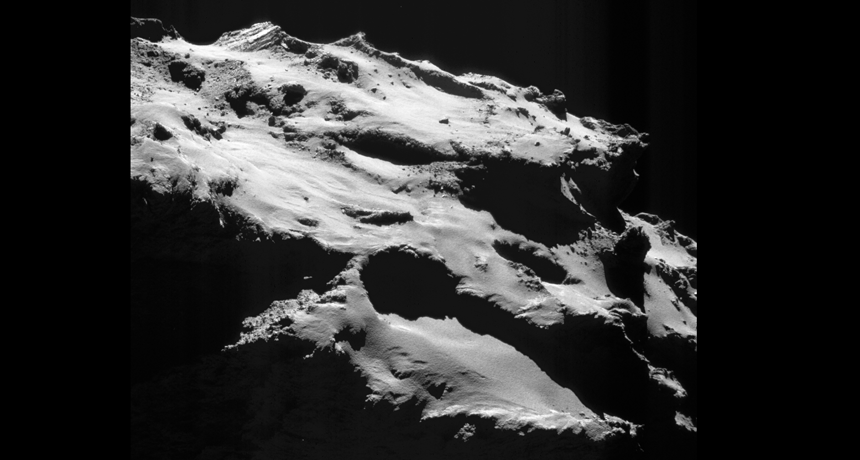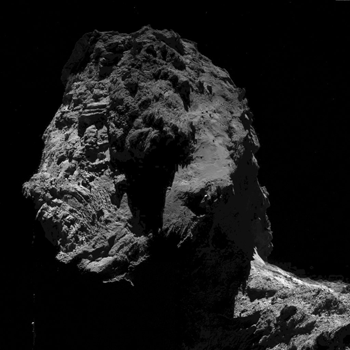Smash hit? Comet mission comes to an end
After two years at comet 67P, the camera-towing Rosetta spacecraft moved in for its last, best closeup

Orbiter’s final resting place is thought to be somewhere on the dusty terrain of this, the comet’s Ma'at region. Rosetta captured this image of the site on September 18.
NAVCAM/Rosetta/ESA, CC BY-SA IGO 3.0
For nearly 26 months, a European Space Agency craft has been orbiting a comet. At 7:19 a.m. Eastern time on September 30, that came to an end. As it prepared to land on the comet’s surface and shut down, the Rosetta spacecraft snapped its last photos and gathered its last data. Then it quickly sent these — the most detailed views of a comet ever — to researchers back home.
The last image was taken 51 meters ( 167 feet) above the surface of comet 67P/Churyumov-Gerasimenko. It showed the spacecraft falling toward a gravelly surface. The landing site has been dubbed Sais. That’s the name of the ancient Egyptian town believed to be the original home of the Rosetta stone, for which the mission was named. “We can say Rosetta has come home,” said Patrick Martin . This planetary scientist is the Rosetta mission manager for the European Space Agency.

The spacecraft launched more than 12 years ago. Rosetta arrived at 67P on August 6, 2014. Some three months later, a lander named Philae detached from the orbiter and dropped to the comet’s surface. It was a rough landing: Philae bounced twice. Then it nicked a ridge before coming to rest on its side in the shadow of a cliff. With too little sunlight to charge its battery, Philae went to sleep about 2.5 days later. Before it did, it sent back to Earth some pictures of its new home.
Unlike Philae, Rosetta was never designed to survive a touchdown on the comet. Though it was due to land at about a walking pace — 3 kilometers (1.9 miles) per hour — this “controlled impact” was expected to likely break apart the spacecraft.
Now that it’s over, “Feelings are mixed,” says mission lead Matt Taylor. He works for the European Space Research and Technology Center in Noordwijk, the Netherlands. He says there is “sadness that this is over, but great joy on what [we’ve] achieved.”
Before bidding the spacecraft goodbye, here’s a look back at five mission highlights.
- One comet, two comet? One surprise emerged as researchers got their first good look at the comet. Described as resembling a rubber duck, comet 67P has two distinct lobes. Some planetary scientists suspect that 67P was once two comets that smooshed together.
- Not just an iceball. Comets are not just big balls of ice, as once thought. Towering cliffs, dusty dunes, shadowy pits — the landscape on 67P is a hodgepodge of terrains. Some of them have been scarred by erosion. Dust has blanketed others under seasonal flows of fine dust. Comets “are much more dynamic than a lot of surfaces in the solar system,” Sunshine says.
- Its water is weighty. Water on the comet is unlike Earth’s. This suggests that comets provided little help in bringing H2O to our planet. The ratio of deuterium (Dew-TEER-ee-um) — a heavy form of hydrogen — to regular hydrogen in the comet’s water is roughly three times as high as that on Earth. Comets as a whole, however, show a large range in this ratio of hydrogen isotopes. This seems to suggest that comets did not all develop the same way.
- Comet 67P carts around a cocktail of chemicals. These include oxygen and noble (inert gases such as argon). Both indicate a birthplace that was cold and far from the sun. Organic (carbon-based) molecules are also present. While asteroids probably delivered the bulk of water to Earth, “comets do have complex organics and could have brought those to Earth and provided the seeds of life,” says Taylor.
- It’s full of holes. The interior of the comet is quite porous. This suggests that 67P was assembled gently 4.6 billion years ago. If true, the comet’s building blocks weren’t altered by being smashed together. And that would support the long-standing idea that comets are time capsules, preserving samples from when our solar system was forming.
Don’t worry. Comet science won’t end with Rosetta. Ground-based telescopes will continue to study these long-distance orbiting bodies from afar. And next year NASA will consider proposals for not only flying a spacecraft to a comet, but also plucking a piece off its surface and bringing it back to Earth.
“As for Rosetta data, there is loads of it,” says Taylor. “There is decades of work to do. So Rosetta isn’t over — it’s just begun.”
Indeed, notes Jessica Sunshine, “Every time you look at a body and increase the resolution … it’s another world.” She’s a planetary scientist at the University of Maryland in College Park. She says of 67P, poring over those data, “It’s going to be very interesting to see what this place looks like.”







